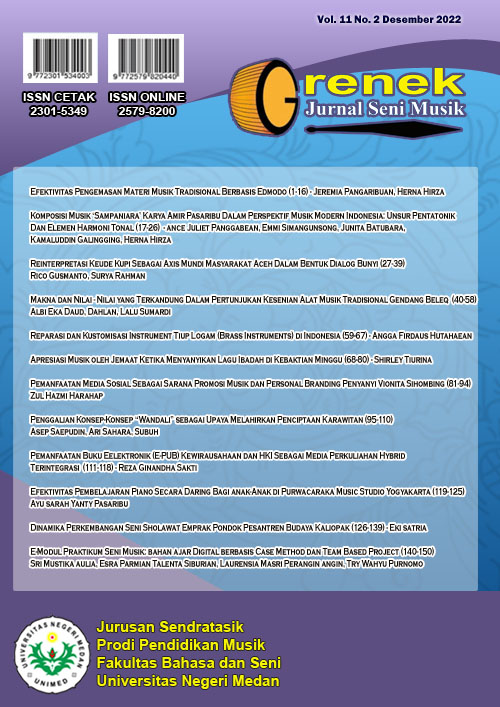Apresiasi Musik Oleh Jemaat Ketika Menyanyikan Lagu Ibadah di Kebaktian Minggu
Main Article Content
Abstract
Article Details

This work is licensed under a Creative Commons Attribution-ShareAlike 4.0 International License.
Authors published with the Grenek: Jurnal Seni Musik agree to the following terms:
- Authors retain copyright and grant the journal the right of first publication with the work simultaneously licensed under a Creative Commons Attribution License (CC BY-SA 4.0) that allows others to share the work with an acknowledgment of the work's authorship and initial publication in this journal.
- Authors are able to enter into separate, additional contractual arrangements for the non-exclusive distribution of the journal's published version of the work (e.g., post it to an institutional repository or publish it in a book), with an acknowledgment of its initial publication in this journal.
- Authors are permitted and encouraged to post their work online (e.g., in institutional repositories or on their website) prior to and during the submission process, as it can lead to productive exchanges, as well as earlier and greater citation of published work. (See The Effect of Open Access)
References
Balslev-Clausen, P. (2009). ˜Hymns and Hymn-Singing as an Indicator of the Situation of the Church™. Dialog, 48(4), 358“363. doi:10.1111/j.1540-6385.2009.00484.x
Boone, R.T., Cunningham, J.G. ˜Children's Expression of Emotional Meaning in Music Through Expressive Body Movement™. Journal of Nonverbal Behavior 25, 21“41 (2001). https://doi.org/10.1023/A:1006733123708
Branigan, R. B. (2007). ˜Movement and Dance in Ministry and Worship™. Liturgy, 22(4), 33“39. doi:10.1080/04580630701551347
Djohan.2020.Psikologi Musik.
Lewis, B. E. (1991). ˜Listeners™ Response to Music as a Function of Personality Type™. Journal of Research in Music Education, 39(4), 311“321. https://doi.org/10.2307/3345750
Levitin, D. J., Grahn, J. A., & London, J. (2018). ˜The Psychology of Music: Rhythm and Movement™. Annual Review of Psychology, 69(1), 51“75. doi:10.1146/annurev-psych-122216-011740
Nelson, T. J. (1996). ˜Sacrifice of Praise: Emotion and Collective Participation in an African-American Worship Service™. Sociology of Religion, 57(4), 379. doi:10.2307/3711893
Osei-Bonsu, R.(2013). ˜John Calvin™s perspective on music and worship, and its implications for the Seventh-Day Adventist Church™. Ilorin Journal of Religious Studies,Vol.3 No.1, 2013, Pp.83-101
Payne, E. (1980). ˜Towards an Understanding of Music Appreciation™. Psychology of Music, 8(2), 31“41. doi:10.1177/030573568082004
Ter Bogt, T. F. M., Mulder, J., Raaijmakers, Q. A. W., & Nic Gabhainn, S. (2010). ˜Moved by music: A typology of music listeners™. Psychology of Music, 39(2), 147“163. doi:10.1177/0305735610370223
Woody, R. H. (2004). ˜Reality-Based Music Listening in the Classroom: Considering Students™ Natural Responses to Music™. General Music Today, 17(2), 32“39. https://doi.org/10.1177/10483713040170020106
Zaluchu, S.E. (2021). ˜Dancing in praise of God: Reinterpretation of theology in worship™. Theologia Viatorum | Vol 45, No 1. OI: https://doi.org/10.4102/tv.v45i1.86
